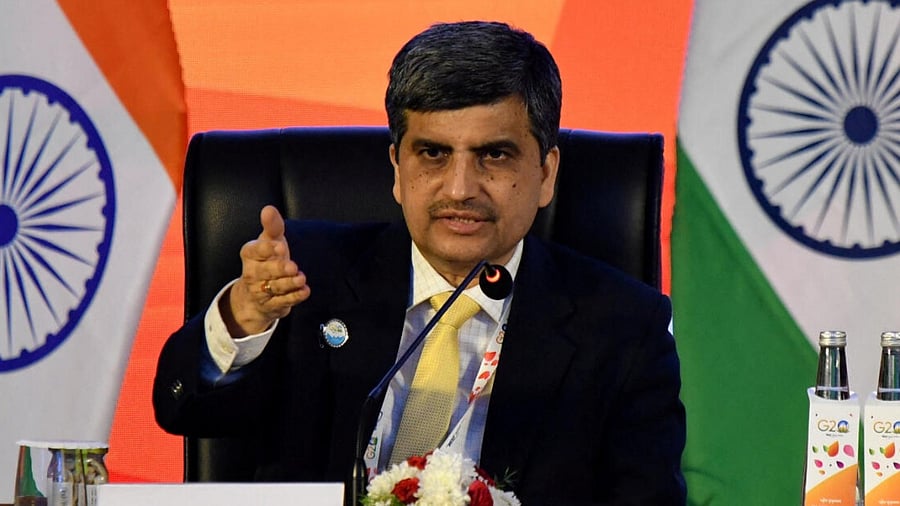
Finance Secretary Ajay Seth.
Credit: PTI File Photo
With global challenges increasingly posing a risk to growth, the need for regulatory reforms to ease the process of doing business becomes more urgent by the day. Smaller economies are opening their doors wide for investors without burdening them with the procedural tangles inherent in India’s bureaucratic framework.
The result is that despite rising interest in the India story, there is hesitation over the persistent regulatory burdens.
In this backdrop, Finance Secretary Ajay Seth’s recent comments about the need for “light touch regulatory reforms” are welcome. He warned against “control freak regulatory tendencies” and unnecessary guardrails that constrict growth.
He also mentioned the Budget proposal for setting up a high-level committee to suggest reforms in the non-financial sector. Another mechanism is proposed under the Financial Stability and Development Council to pursue similar initiatives in the financial sector. These are laudable plans. The only hitch is that launching them is taking an inordinately long time.
The creation of committees is normally a diversionary tactic to delay policies that could be difficult in implementation. In this case, however, even government spokespersons are voicing support for procedural and regulatory reforms. The delay in moving forward is thus inexplicable.
It is all the more mystifying given the fact that external headwinds are becoming more difficult to navigate than at any other time in the recent past. Geopolitical tensions continue to simmer while protectionist tendencies are growing around the world. The uncertainties in the global arena have been highlighted by Seth himself who warned these may not subside in the medium term, while noting there is need to do things differently so that India emerges as a developed nation by 2047.
His comments find resonance in the latest finance ministry report which speaks about geopolitical fissures and the uncertainty around trade policies, along with volatility in international commodity and financial markets. The report has clearly pointed to these factors posing significant risks to the outlook for growth next year. The cautionary words come even though India remains the fastest growing major economy in the world with growth expected to be around 6.5% in 2024-2025. The question is whether there will be the same momentum in FY2026, in the light of expectations that the global scenario is not likely to see much change.
This includes the conflicts in Ukraine and Gaza that continue to have repercussions on the world economy. Despite peace efforts being made by the Donald Trump administration on the Russia-Ukraine front, an early cessation of hostilities looks unlikely. This means that energy prices will remain volatile in Europe despite most countries in the continent shifting to alternative gas suppliers after delinking from Russia. The Israel-Hamas war also continues to have ramifications by way of trade flows being disrupted through the region.
Another factor that looks set to weigh on both developed and developing nations is the shift in trade policies by the world’s largest economy. The United States is right now at loggerheads not just with China but with most of its key allies in Europe and North America. As far as India is concerned, there is considerable uncertainty even though a bilateral trade treaty is under negotiation. It could enable a balance to be reached between Washington and New Delhi over the need to access each other’s markets. Yet there could equally be issues relating to sensitive areas like agriculture in India or the need to bring down non-tariff barriers in the US. This could impede growth in exports to the lucrative US market.
Finally, international financial markets are continuing to be volatile in the wake of the US Federal Reserve easing interest rates. Indian bourses have gone through some rough weather over the past six months because of foreign institutional investors looking for higher returns elsewhere. The tide seems to be turning, and domestic markets are recovering slowly. But the world still must contend with the prospect of recession in the US economy as a result of Trump’s new aggressive trade policies. Goldman Sachs has upped recession chances to 35% from 20% earlier and it is this fear that is bound to lead to market fluctuations.
At a time of flux in the world, the Indian economy must have the resilience to weather coming storms. One way of providing this is to deepen the process of regulatory reforms. Ridding the system of outmoded controls will enhance ease of doing business for both domestic and foreign investors. It will also enable India to emerge as a preferred and stable investment destination. With external turmoil deepening, these reforms need to be taken sooner rather than later. Otherwise, growth will fail to reach the heights needed for India to become a developed economy by 2047.
(Sushma Ramachandran is a senior journalist.)
Disclaimer: The views expressed above are the author's own. They do not necessarily reflect the views of DH.